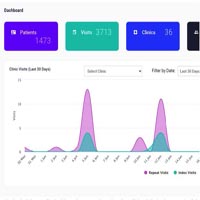Health service delivery for type 1 diabetes during the lockdown in Uganda following the coronavirus disease 2019 pandemic

Accepted: 11 November 2021
Supplementary Figure: 39
HTML: 18
All claims expressed in this article are solely those of the authors and do not necessarily represent those of their affiliated organizations, or those of the publisher, the editors and the reviewers. Any product that may be evaluated in this article or claim that may be made by its manufacturer is not guaranteed or endorsed by the publisher.
Lockdown measures to reduce the spread of coronavirus disease 2019 (COVID-19), may adversely impact on diabetes supplies and metabolic control, especially in type 1 diabetes in low-resource countries. To address this, we conceptualized a service delivery model that incorporated a digitized tool. The digitized tool (UT1D-HIMAS) maintained electronic health records, monitored clinic supplies, patient clinic visits and admissions, and sent automated SMS messages. Delivery of supplies was by motor vehicles, motorcycles, bicycles or patients/caregivers walking to clinics. Metabolic control was assessed by glycated haemoglobin (HbA1c). Monitoring of clinic supplies including emergency restocking, patient clinic visits and admissions, and sending automated SMS by UT1D-HIMAS were successfully achieved. A fall in clinic visits, reaching a nadir (67.9%) in May 2020 was observed. HbA1c (mean ± SD mmol/mol) significantly (p= 0.040) worsened from 79.1 ± 26.8 to 94.9 ± 39.2 and (p=0.002) from 67.1 ± 22.7 to 84.8 ± 39.4 in the rural and urban clinic respectively. The digitized health information system exhibited high practicability in tracking stocks, clinic visits and hospitalisation but failed to improve metabolic control.
Yesudhas D, Srivastava A, Gromiha MM. COVID-19 outbreak: history, mechanism, transmission, structural studies and therapeutics. Infection 2021;49:199-213.
World Health Organization. (2020). WHO Director-General's opening remarks at the media briefing on COVID-19 - 11 March 2020. Accessed on 15 August 2020. Avalable from: https://www.who.int/dg/speeches/detail/who-director-general-s-opening-remarks-at-the-media-briefing-on-covid-19---11-march-2020
Federica M, Pattnaik A, Jordanwood T, et al. (2020). Case study: The initial COVID-19 response in Uganda. Washington, DC: ThinkWell and Ministry of Health Uganda. Accessed on 23 October 2021. Available from: https://thinkwell.global/wp-content/uploads/2020/09/Uganda-COVID-19-Case-Study-_18-Sept-20201.pdf
Migisha R, Kwesiga B, Mirembe BB, et al. Early cases of SARS-CoV-2 infection in Uganda: epidemiology and lessons learned from risk-based testing approaches - March-April 2020. Global Health 2020;16:114.
Bahendeka S, Mutungi G, Tugumisirize F, et al. Healthcare delivery for paediatric and adolescent diabetes in low resource settings: Type 1 diabetes clinics in Uganda. Global Public Health 2019. doi: 10.1080/17441692.2019.1611897
Collaboration on International ICT Policy for East and Southern Africa (CIPESA). (2018) National Information Technology Survey 2017/18 Report. Accessed 03 March 2020. available from: https://www.nita.go.ug/sites/default/files/publications/National%20IT%20Survey%20April%2010th.pdf
Hartmann-Boyce J, Morris E, Goyder C, et al. Managing diabetes during the COVID-19 pandemic2020. Accessed on 06 February 2021. Available from: https://www.cebm.net/covid-19/managing-diabetes-during-the-covid-19-pandemic/
Kompala T, Neinstein AB. Telehealth in type 1 diabetes. Curr Opin Endocrinol Diabetes Obes 2021;28:21-9.
Kyokunzire C, Matovu N. Factors associated with adherence to diabetes care recommendations among children and adolescents with type 1 diabetes: a facility-based study in two urban diabetes clinics in Uganda. Diabet Metabol Syndr Obes Targets Ther 2018;11:93-104.
Mbanya JC, Naidoo P, Kolawole BA, et al. Management of adult patients with type 1 diabetes mellitus in Africa: A post-hoc cohort analysis of 12 African countries participating in the International Diabetes Management Practices Study (Wave 7). Medicine (Baltimore) 2020;99:e20553.
Tenywa G. COVID-19: Foods you must eat to boost your immunity. New Vision, 2020. Accessed on 31st March 2020. Available from: https://www.newvision.co.ug/news/1517308/covid-19-foods-eat-boost-immunity
Kasozi KI, MacLeod E, Ssempijja F, et al. Misconceptions on COVID-19 Risk Among Ugandan Men: Results From a Rapid Exploratory Survey, April 2020. Front Public Health 2020;8:416.
Usman IM, Ssempijja F, Ssebuufu R, et al. Community Drivers Affecting Adherence to WHO Guidelines Against COVID-19 Amongst Rural Ugandan Market Vendors. Front Public Health 2020;8:340.
Trevisani I, Bruzzi P, Madeo SF, et al. COVID-19 and Type 1 Diabetes: Concerns and Challenges. Acta Biomed 2020;91:e2020033.
Ministry of Health Uganda Government. Uganda Government, Ministry of Health, Coronavirus (Pandemic) COVID-19, 2020: Accessed on 28 June 2020. Available from: https://www.health.go.ug/covid/
Igloos Consultancy: Francis. (2019). How many languages Uganda has? Accessed on 10 October 2020. Available from: https://igloosconsultancyservices.com/how-many-languages-uganda-has/


 https://doi.org/10.4081/hls.2021.9799
https://doi.org/10.4081/hls.2021.9799



